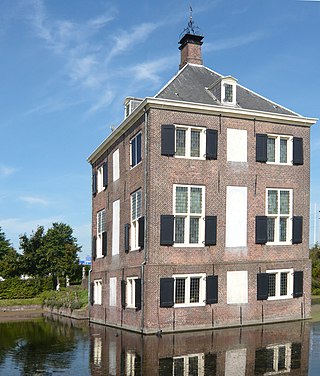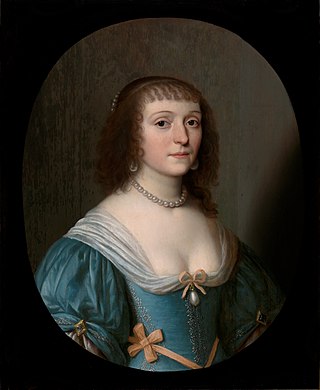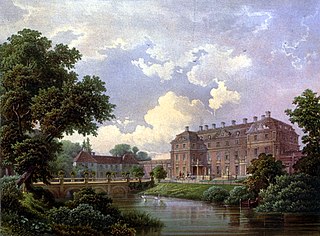
Vianen is a city and a former municipality in the central Netherlands, in the province of Utrecht. It is located south of the Lek river. Before 2002 it was part of the province of South Holland. Vianen is made up of a historic town centre that dates back to the medieval period and was once surrounded by a defensive wall and moat, as well as more extensive modern housing developments to the east, south and southwest and an industrial and commercial area. Vianen is intersected by two major motorways leading to the city of Utrecht: the A2 (Amsterdam-Maastricht) and the A27 (Breda-Almere). The municipality was merged with the municipalities of Leerdam and Zederik on 1 January 2019. The name of the new municipality is Vijfheerenlanden which is part of the Utrecht province.

Amalia of Solms-Braunfels was Princess of Orange by marriage to Frederick Henry, Prince of Orange. She acted as the political adviser of her spouse during his reign, and acted as his de facto deputy and regent during his infirmity from 1640 to 1647. She also served as chair of the regency council during the minority of her grandson William III, Prince of Orange from 1650 until 1672.

Muiden Castle is a castle in the Netherlands, located at the mouth of the Vecht river, some 15 kilometers southeast of Amsterdam, in Muiden, where it flows into what used to be the Zuiderzee. It is one of the better known castles in the Netherlands and featured in many television shows set in the Middle Ages.

Hofwijck is a mansion built for 17th-century politician Constantijn Huygens. It is located in Voorburg on the Vliet canal from The Hague to Leiden. Formal address of the cultural heritage is 2 Westeinde, Voorburg, the Netherlands, but its location today is better known as the Voorburg railway station.

Braunfels is a town in the Lahn-Dill-Kreis in Hesse, Germany. It is located on the German Timber-Frame Road.

Doorwerth Castle is a medieval castle situated on the river Rhine near the city of Arnhem, Netherlands.

The Lords of Brederode were a noble family from Holland who played an important role during the Middle Ages and the Early modern period. The family had a high noble rank and hold the titles Count of Brederode, Count of Gennep, and furthermore they ruled the souverain Lordship of Vianen, the Viscountship of Utrecht among other feudal titles.

Breda Castle is a castle in the city of Breda, in the Netherlands.

Egmond Castle, also called the Ruins of Egmond, is a ruined medieval castle in the Dutch province of North Holland. It is located in Egmond aan den Hoef in the municipality of Bergen and lies about 7 kilometres (4.3 mi) west of Alkmaar. The castle dates from the 11th century and is the ancestral seat of the Egmond family, whose members became sovereign Dukes of Guelders, Counts of Egmond and Princes of Gavere, Counts of Buren and Leerdam. It is a national monument of the Netherlands.

Brederode Castle, also called the Ruins of Brederode, is located near Santpoort-Zuid. The castle was founded in the second half of the 13th century by William I van Brederode (1215–1285). William was a descendant of the lords van Teylingen, who were related to the counts of Holland. The castle formed part of the high lordship Brederode, which had been given in loan in the 13th century to the lords of Brederode by the count of Holland.

Walraven II van Brederode was Lord of Brederode, Vianen, Ameide, Bailiff of Hagestein and Burgrave of Utrecht.

Princess Mauritia Eleonora of Portugal, Dutch: Prinses Mauritia Eleonora van Portugal, was a princess from the House of Aviz. As a close relative of Prince Frederick Henry of Orange, she spent a long time at his court in The Hague. Later in life she married a count from the House of Nassau-Siegen.

Christian Albert, Burgrave and Count of Dohna was a German nobleman from the House of Dohna.

Frederick, Burgrave of Dohna was a German nobleman, an officer in Dutch service and a governor of the Principality of Orange. He later also rendered services to the Electorate of Brandenburg. Near the end of his life, he chose Switzerland, where he was highly regarded, as his adopted country.

Cannenburg Castle or Cannenburch Castle is a castle with a moat in the Netherlands. It is situated in Vaassen, a town in the province of Gelderland.

Countess Anne Joanne of Nassau-Siegen, German: Anna Johanna Gräfin von Nassau-Siegen, official titles: Gräfin zu Nassau, Katzenelnbogen, Vianden und Diez, Frau zu Beilstein, was a countess from the House of Nassau-Siegen, a cadet branch of the Ottonian Line of the House of Nassau, and through marriage Lady of Brederode, Vianen, Ameide and Kloetinge.

Coldenhove Castle was a castle in Eerbeek, the Netherlands. Due to its excellent location in the Veluwe, the castle used as hunting lodge by the dukes of Guelders and the princes of Orange. Nothing remains anymore of the castle or its gardens.

The siege of Vredelant took place from late 1279 to 1280 and was fought between Floris V of Holland and Bishop-Elect John I of Nassau on one side and the rebellious Van Amstel family on the other side. The castle of Vredelant was taken within weeks when Gijsbrecht IV van Amstel was captured by the count's soldiers.

Castle Buren or Buren Castle was a princely residence in Buren in the Dutch province of Gelderland. The castle was one of the largest castles in the Netherlands. It was the seat of the Buren branch of the Egmond family, as well as of the House of Orange. It has been demolished in the 19th century. Today, not much remains except a monument in the former bailey of the castle as well as model in the local museum.

Schlobitten Palace is a ruined baroque palace in Słobity, in the Warmian-Masurian Voivodeship in Poland. Formerly, it was part of East Prussia. The palace, constructed between 1622 and 1624, was the seat of the Schlobitten branch of the Dohna family. In 1945, it was looted and plundered by the Red Army, before it was set afire. Since then it has been a ruin.





























